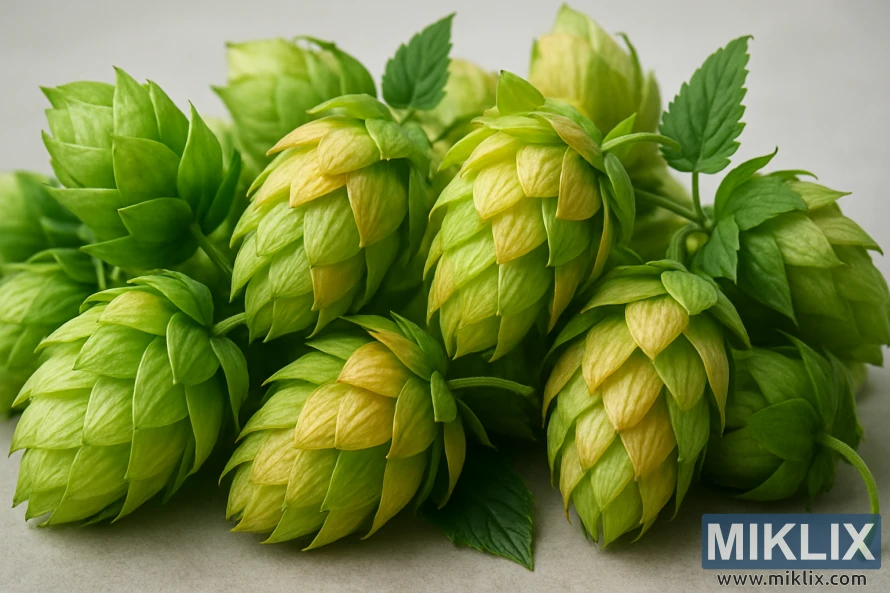Image: Fresh Petham Golding Hops
Published: August 10, 2025 at 11:12:34 AM UTC
Last updated: September 27, 2025 at 8:49:44 AM UTC
High-quality close-up of Petham Golding hops with green and golden hues, showcasing their texture, beauty, and importance in brewing craft beer.
Spread across the frame with a natural elegance, the freshly harvested Petham Golding hop cones radiate a vibrant harmony of color and texture, captured in exquisite detail under soft, diffused light. Their overlapping bracts form intricate, scale-like patterns, each layer slightly translucent at the edges where the light touches, creating a delicate interplay between green and golden hues. Some cones lean toward a bright, almost lime-green freshness, while others transition into deeper yellow tones, suggesting ripeness and the concentration of aromatic lupulin within. This palette of colors evokes both vitality and maturity, highlighting the dual role of these hops as living plants and as critical ingredients in the brewing process. Their arrangement feels both deliberate and organic, as if freshly gathered from the bine and carefully laid out to showcase their natural artistry.
The cones themselves appear plump and healthy, each one tightly packed, their surfaces marked by subtle variations in shading and form. Their leafy texture draws the eye inward, inviting closer inspection, almost tempting the viewer to imagine gently rolling one between their fingers and releasing the burst of resinous oils within. These glands, invisible here but deeply present in the structure of the cones, hold the essence of bitterness, aroma, and flavor that defines the brewer’s craft. The inclusion of a few green leaves and stems among the cones anchors the image, reminding us of their agricultural origins, of fields lined with tall hop bines climbing skyward in careful rows, nurtured by soil, sun, and patient hands. Even against the clean, muted background, the hops maintain a sense of vitality and connection to nature, their colors and shapes asserting both their beauty and their function.
The lighting enhances the mood of reverence and craftsmanship. Soft and even, it avoids harsh contrasts, instead emphasizing the gentle curves and layered folds of the cones. Shadows are subtle, creating depth without distraction, while highlights bring out the slight glossiness of the hop bracts. This creates a serene, almost contemplative atmosphere, where the hops are not just ingredients but objects of admiration, worthy of appreciation in their raw, untransformed state. The composition, simple yet striking, isolates the cones from distraction, encouraging the viewer to dwell on their intricate forms and inherent potential. In this way, the photograph transforms a humble crop into a visual emblem of artisanal brewing.
The Petham Golding variety, with its long history and distinctive qualities, seems to carry a quiet dignity in this portrayal. Known for its refined bitterness and delicate, earthy-spicy aroma, it is a hop that embodies tradition and subtlety rather than overpowering intensity. The visual representation here mirrors that reputation: understated yet beautiful, restrained yet complex. The cones symbolize not just a raw material but a heritage of brewing, a lineage of taste that stretches back centuries. In their golden-green glow lies the promise of balance, character, and craftsmanship—the heart of brewing distilled into its most essential form. This image captures that spirit, inviting the viewer to appreciate the artistry hidden within each cone, and to reflect on the journey that transforms them from field to fermenter, and finally into the glass.
The image is related to: Hops in Beer Brewing: Petham Golding

